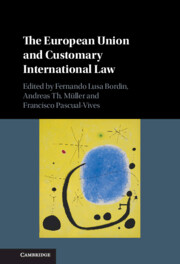Book contents
- The European Union and Customary International Law
- The European Union and Customary International Law
- Copyright page
- Contents
- Contributors
- Acknowledgements
- Cases
- Treaties
- Abbreviations
- Introduction
- Part I A View from the Outside
- 1 Applicability of Customary International Law to the European Union as a Sui Generis International Organization
- 2 Is the European Union a Sui Generis International Organization?
- 3 The European Union’s Role in the Making and Confirmation of Customary International Law
- Part II Looking in Between
- Part III A View from the Inside
- Index
3 - The European Union’s Role in the Making and Confirmation of Customary International Law
from Part I - A View from the Outside
Published online by Cambridge University Press: 27 October 2022
- The European Union and Customary International Law
- The European Union and Customary International Law
- Copyright page
- Contents
- Contributors
- Acknowledgements
- Cases
- Treaties
- Abbreviations
- Introduction
- Part I A View from the Outside
- 1 Applicability of Customary International Law to the European Union as a Sui Generis International Organization
- 2 Is the European Union a Sui Generis International Organization?
- 3 The European Union’s Role in the Making and Confirmation of Customary International Law
- Part II Looking in Between
- Part III A View from the Inside
- Index
Summary
Much of the debate about the EU and customary international law addresses the conditions under which customary international law is applied within the EU legal order, such as when it is used to challenge the validity of EU acts. To what extent can the EU also contribute to the development and identification of customary international law? This chapter argues that the EU is not only bound by customary international law, but can also contribute to the development and identification of customary law in its own right. It examines these questions in light of the International Law Commission’s 2018 Draft Conclusions on Identification of Customary International Law. It first discusses some of the conceptual issues faced by the ILC and some of the ways that the EU may contribute to the development of customary international law through its practice and opinio juris. The chapter then turns to the role of the Court of Justice of the European Union and the role it plays in the development and identification of customary international law. It argues that EU practice is relevant when determining rules that apply to the relationship between the EU and third states and organizations.
Keywords
- Type
- Chapter
- Information
- The European Union and Customary International Law , pp. 66 - 94Publisher: Cambridge University PressPrint publication year: 2022



